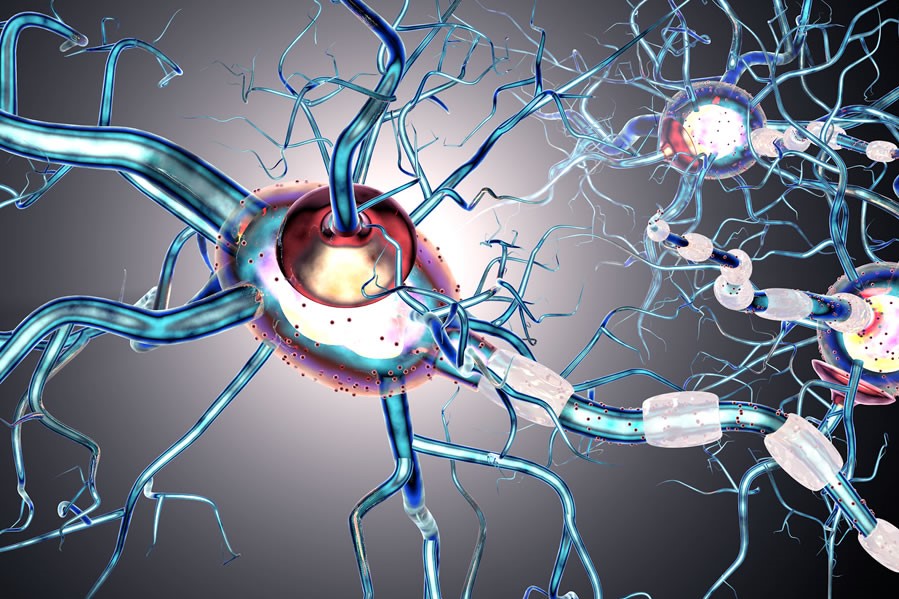
Multiple Sclerosis: What are the symptoms of MS?
Multiple Sclerosis is a chronic (lifelong) and progressive (tends to degenerate over time) disease
This disease attacks and irreparably damages the entire nervous system, causing the degeneration of myelin, the substance lining the nerves in our body.
It is thanks to this substance that electrical impulses, starting from the brain, arrive in a correct and immediate manner to the peripheral parts of our body or return from the periphery to the brain; it is therefore clear that a permanent destruction of this lining implies serious damage to motor coordination, movements, and the transmission of nerve impulses in general.
Symptoms of multiple sclerosis
Symptoms related to multiple sclerosis can differ depending on the area of the nervous system affected by the demyelination process.
Usually movement and sensory functions are affected.
Patients may experience:
- widespread weakness
- paralysis of limbs
- vision problems
- muscle pain
- tremors
- loss of balance
- speech disorders
- loss of control of urination or stool output
- impotence
- memory and reasoning disorders.
Of these symptoms, the most frequent are related to lower limb movements, muscle pain, weakness and faecal and urinary incontinence.
There are four forms of multiple sclerosis:
Benign multiple sclerosis. This is the mildest form and does not degenerate over time, but causes at most a couple of attacks in all that can be resolved with optimal recovery without leaving permanent damage.
Primary progressive multiple sclerosis.
It presents itself as a chronic disease from its onset and with a degenerative and progressive course.
Usually, the disease appears around the age of 40, which is rather later than the age at which it usually appears.
Typical symptoms are mainly movement and coordination disorders.
Relapsing-remitting multiple sclerosis.
It presents itself as a disease in which attacks are frequent; new symptoms progressively appear or worsen those already present (relapsing phase), which then regress (remitting phase).
This regression, however, becomes less and less complete with the passage of time, transforming the relapsing-remitting form into a secondary progressive form.
Secondary progressive multiple sclerosis.
This is the final stage of relapsing-remitting multiple sclerosis and presents a progressive and degenerative course that can lead to disability.
Myelin function
We have said that myelin is the nerve lining substance that enables the rapid and complete transmission of nerve impulses from the brain to the periphery and vice versa.
Myelin has interruptions on its surface called nodes of Ranvier.
It is actually these nodes that make the transmission of the nerve impulse acquire more speed, since, by jumping from one to the other, the transmission occurs faster than the time it would take if it had to cross the entire nerve.
In fact, when the myelin is damaged or even destroyed, the speed of transmission decreases dramatically because the impulse can no longer rely on the nodes of Ranvier, but is forced to transmit along the entire length of the nerve or may even block.
The destroyed myelin is replaced by so-called plaques; these are real lesions that slow down or block the transmission of nerve impulses, thus causing a kind of information blackout.
This leads to irreparable consequences that affect the nervous system and thus also the senses: coordination of movements, sight, hearing, but also the most elementary bodily functions, such as the emission of faeces and urination, being no longer supervised by the brain, are beyond the control of the affected patient.
Epidemiology and aetiology of multiple sclerosis
There are approximately 50,000 people with multiple sclerosis in Italy, rising to approximately 450,000 in Europe and 1 million worldwide.
The patients are all young people between the ages of 20 and 40; no cases of multiple sclerosis have been found in the child population, nor in the elderly.
Most frequently this disease attacks women 50% more frequently and people of all races, although researchers have noted a higher incidence in Caucasians than others.
Multiple sclerosis is not a contagious disease, nor, above all, is it hereditary, although cases of multiple sclerosis have been found within the same family.
The genetic component, therefore, especially taking into account the fact that monozygotic twins in particular are affected, could be a susceptibility factor for the development of the disease.
The real trigger, however, is still unknown.
Multiple sclerosis can be classified as an autoimmune disease, i.e. a disease in which the body can no longer distinguish between foreign substances and its own substances and attacks the latter in the same way as the former.
In multiple sclerosis sufferers, in fact, myelin is destroyed by the various white blood cells, macrophages, T-lymphocytes and B-lymphocytes, that make up the patient’s immune system.
This reaction of the white blood cells against the organism they are supposed to be defending appears to be triggered by a common virus, such as those of childhood diseases.
Read Also:
Emergency Live Even More…Live: Download The New Free App Of Your Newspaper For IOS And Android
Rehabilitation Therapies In The Treatment Of Systemic Sclerosis
First Case Of Meningitis Associated With SARS-CoV-2. A Case Report From Japan
Relapsing-Remitting Multiple Sclerosis (RRMS) In Children, EU Approves Teriflunomide
ALS: New Genes Responsible For Amyotrophic Lateral Sclerosis Identified


